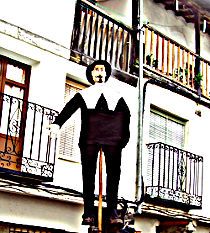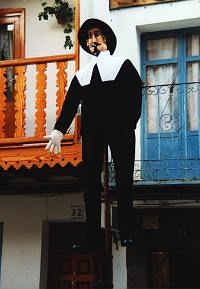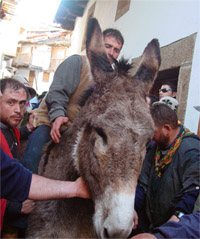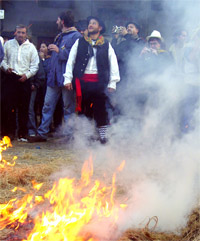
FAQs in English
Lunes 28 de febrero de 2011, por Jilandero (actualizado el 21 de enero de 2025) FAQs in ENGLISH in PDF
As every year, the arrival of carnival brings the “Peropalo”, a life sized puppet who, in Villanueva de la Vera, is the main character of this event. During these days there are several celebrations, all connected, which make of Peropalo one of the best examples (albeit the deformations introduced throught he centuries), of the agrarian fertility rites celebrated during winter in most of the pre-roman Europe. As a matter of fact, from the union of some of these rites, present in some roman festivals, derives the carnival, since the explosion of freedom in all orders of these pagan events was reconducted by the Church in the middle ages, condensating them in the days previous to lent, the start of which marked the next change of season.
In Villanueva de la Vera, the conducting link of all these pagan elements has been, and is, Peropalo. In its trial and ritual death still participates all the village, understanding thus the actual meaning of the event as an collective explosion of common identity.
What is the celebration of Peropalo?
 The carnival has been celebrating in Villanueva de la Vera (Cáceres) since no recorded time. It is the celebration of a village getting together to have fun, to sing and dance, eat and drink…doing it around a puppet whose destiny is, after being paraded through the village, to die by being burned on Tuesday afternoon.
The carnival has been celebrating in Villanueva de la Vera (Cáceres) since no recorded time. It is the celebration of a village getting together to have fun, to sing and dance, eat and drink…doing it around a puppet whose destiny is, after being paraded through the village, to die by being burned on Tuesday afternoon.
The carnival is the period when the world is turned “upside down” and social conventions are broken. Disinhibition helps people to have fun and manifest itself to others with no barriers. This is helped by the costume, the soot in the face, the drinks…everything is allowed as long as the community´s harmony is not broken by senseless violence or the abuse of the strong over the weak. It´s time for joking, laughing, satire…briefly, for partying. It´s time for contact, rubbing, hugging, jumping and shoving, as well as for singing and yelling.
How is the celebration lived by the people?
In Villanueva, men wear loose shirts of old times or outlandish clothes. Women dress as they please although most wear regional costumes. Life is lived outside of the houses, in the square. People sing in small or large groups. There is dancing in the streets, in the square and in the taverns, sometimes in an encompassed and others in a chaotic way. It is the time for noise, anarchy and of music harmonized in the musical groups; of scruffy clothing and beautiful shawls and underskirts. It´s the exclusive moment for fun, abbandonment of daily worries, of excess in consumption as long as the body whithstands it…
What is Peropalo?
Peropalo is the axis of Villanueva´s carnival, the simbol of a celebration which is exclusively recreational, for the fun of people. It is not it´s excuse but its unifying factor, although one may adopt contrary positions about it: some wish for it to live and others, close by, yell for it to die. There are women who wear mourning clothes at it´s death and others dance in happiness. It´s unity between contradictory elements, such as in real life, and even more: Peropalo is a symbol of freedom, of vital joy and of the genetic forces of nature, a celebration of great chromatic and musical beauty and an example of a village´s identity. Also, it is a token of the human condition frailty.
What is the relationship between Peropalo and the jews?
In Peropalo, realistic elements which narrate historical facts and processes mingle with others of simbolic nature. With the passing of time, some connotations have been added which hide it´s primitive magic meaning. However, the main character has always prevailed and, from the renaissance on, it was given an anti-jewish meaning, due to the special circumstances lived in those times. The puppet was named Jude, same as other puppets being burned during easter popular holidays. Today, the aggressive tone found in the lyrics of most songs does not have a real sense; it´s just a celebratory element used to justify the death of the main character.
What about the contoversy about the use of a donkey during the celebration?
 Since the end of the eighties, some animal protection organizations, mainly form France and the United Kingdom, denounced a bad treatment of a donkey in the “corrida de las elecciones” on Tuesday morning. However, these denounces were based of false tales risen from a misinterpretation made when taking the act out of context. In the last decades it came into fashion to sing the very popular song “the donkey died” during the event, and the animal protection people thought that a donkey was killed. As a matter of fact, they have denounced inexistent deeds, such as the donkey being thrown out of a balcony, or thrown to a fountain, or of one of his eyes being taken out and, even, that he is skinned and eaten raw. The people from Villanueva admit that maybe during the eighties could this part of the ritual be developed with less control, but these horrible things never happened.
To avoid any confusion, the same donkey is used every year and a “donkey supervising group” has been put into place to manage this act which, as usual, takes place without incidents.
Since the end of the eighties, some animal protection organizations, mainly form France and the United Kingdom, denounced a bad treatment of a donkey in the “corrida de las elecciones” on Tuesday morning. However, these denounces were based of false tales risen from a misinterpretation made when taking the act out of context. In the last decades it came into fashion to sing the very popular song “the donkey died” during the event, and the animal protection people thought that a donkey was killed. As a matter of fact, they have denounced inexistent deeds, such as the donkey being thrown out of a balcony, or thrown to a fountain, or of one of his eyes being taken out and, even, that he is skinned and eaten raw. The people from Villanueva admit that maybe during the eighties could this part of the ritual be developed with less control, but these horrible things never happened.
To avoid any confusion, the same donkey is used every year and a “donkey supervising group” has been put into place to manage this act which, as usual, takes place without incidents.
What is the relationship between the Inquisition and this celebration?
Tradition says that in the year 81 (century unknown), the Peropalo people were taken to Llerena, site of the Holy Office in charge of Extremadura matters, accused of killing a man every year. The accusation had to specify that such killing had jewish ritual patterns, since the Llerena court, being inquisitorial, had no power over civil matters.
At the end, the proceedings demonstrated that the Peropalo people simply portrayed the death of a jewish man. They were absolved and were given drums and a pair of halberds, which were incorporated to the celebration since then.According to tradition, the king was present during the celebration and he liked it very much, so he donated them. This gives reason to think, given the scarce trips of the kings to Extremadura, that this incident took place in the sixteenth century, since Phillip the second made a trip that year to be crowned king of Portugal. He made his return during the first days of the year and that is the reason why “the first day of the year (as the song goes) we must sound the drum, as in Llerena we won over the holy Inquisition”. Halberds were a main element of the royal guards since 1504, when the halberdiers corps was created for the protection of the Catholic Kings, Ferdinand and Isabella.

What happens with the puppet?
The main character, being of a flokloric nature, requires always a series of rites that are repeated every year, and which give an identity to the puppet. It is manufactured secretly duirng Saturday night and, during the early hours of Sunday, bars and discos get empty so as to accompany the Peropalo people for the placing of the puppet “in its rifghtful place”, the “needle of dishonour”. There it will stay, in different positions, during the days of celebration. On sunday and monday it gets taken for a walk through the village streets. All end up at the square, for the bean stew and “jota” dances.
What happens the great day (Día grande)?
Tuesday is the day with the larger number of events. The puppet is condemned to death for its sexual excesses and is forced to walk the sentence riding a donkey. In this case, it is a young man who substitutes the puppet on the animal, around which all the youths congregate. For the sake of realism, the Captain of the celebration, the steward of other events, is handed a flag andto his companions, some halberds. The general satisfaction for the judgement is celebrated with a general invitation to sweets and lemonade.
The brightest events take plce during the afternoon. The start is a comic offering, the “Offer of the pumpkin people” in which those who come forward to give some money are not thanked for it but instead are hit with pumpkins.

There is a secular pocession, the “Walk” in which part of the community, especially women dressed in beautiful regional dresses, accompany the captains. These walk protected by a group of halberdiers. The man carries the flag of the event and the woman brings with her a thick bramble from which a “chorizo” (red sausage) is hanging, the simbol of the Peropalo´s genitals. During the route there is singing of traditional songs and stanzas. The walk concludes in the square and the “Dance of the flag” starts, where the men turn the flag in exercises of ability and strength.

How does the celebration end?
 The end of the event is known beforehand. The rite culminates with the beheading, chopping into pieces, tossing in a blanket and death of the puppet. On his way to death it is accompanied by the weepers who lament its inevitable destiny and remember its sexual prowesses. While he is tossed in a blanket, the musketeers shoot it and its remains are burned. The doubling of drums with a long “jota” dance put the final touch to the celebration. The ashes of Peropalo, scattered through the square, will have the power of revitalising nature.
The end of the event is known beforehand. The rite culminates with the beheading, chopping into pieces, tossing in a blanket and death of the puppet. On his way to death it is accompanied by the weepers who lament its inevitable destiny and remember its sexual prowesses. While he is tossed in a blanket, the musketeers shoot it and its remains are burned. The doubling of drums with a long “jota” dance put the final touch to the celebration. The ashes of Peropalo, scattered through the square, will have the power of revitalising nature.
The strenght of the character is such that, although in the stanzas sung through the celebration it is associated with Jude and the jews, the Peropalo is much more. It is known also as “Revive”. Naturally, the main character will revive next year, with the same outfit and figure and, of course, with the same mission: to bring joy to a village.
